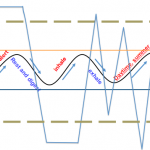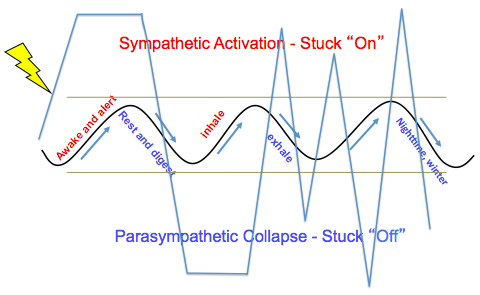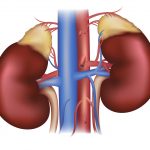Trauma Training Tip
I often draw this image for my clients. I affirm for them that the zone of resiliency in the center, which acupuncturists will easily recognize as the organic movement between yin and yang; is always there for us. Nothing can break nature’s fundamental rhythm between day and night, summer and winter. When an overwhelming experience causes a rupture in the boundary that holds our Qi, we become stronger, faster, clearer and more able to mount a successful and life protective “fight or flight” response. This hyper-aroused state is designed to be short-lived, and then usher us back to our zone of resiliency.
However, if we were unable to fight or flee, our capacity to respond was snuffed out by previous trauma, we were too young or too small, the threat is too big or too powerful, or our efforts were thwarted, we may become quite dysregulated, like the jagged line on this image.
Trauma survivors’ symptoms arise out of an incomplete self-protective response, together with their constitutional strengths and weaknesses. It is almost impossible to successfully fight or flee natural disasters, such as fires, hurricanes, or floods. Other circumstances are more insidious and pervasive — like racist violence, sexual trauma, or child abuse — but can also give rise to this kind of dysregulation when the threat is nearly constant and successful negotiation is so challenging. 
When this “lightning bolt” of trauma hits, the boundary around our zone of resiliency is ruptured, it can no longer contain ordered Qi. Unable to successfully navigate this threat, our Qi can become stuck on “On” – residing “above” the upper level of our zone of resiliency and we are hyper-aroused. Our Qi can also collapse to “below” the lower level of the this zone. We are hypo-aroused, or dissociated. It can fluctuate wildly between hyper- and hypo-arousal – which is the foundation of the chronic multi-symptom illness that plagues so many people who seek acupuncture. Despite our best efforts, we are unable to restore our equilibrium or harvest the lessons that would otherwise protect us in future similar circumstances.
Acupuncture and Asian Medicine’s fundamental tenet of restoring balance and regulation between yin and yang is a powerful gift to people whose energy body was overwhelmed by life-threatening experiences. We can safely assume that many of the patients who come to us with “strange, rare, and peculiar” symptoms have a background that includes overwhelming stress. Auto-immune illness, obesity, chronic pain, addiction, problems with digestion or metabolism of nutrients — as well as anxiety and depression all have tendrils in autonomic nervous system dysregulation arising from traumatic stress. Approaches like acupuncture that serve overall regulation rather than focusing on a particular disease or symptom are critical for these people.
Alaine’s Two Cents
Building capacity in the Water Element during the Winter will help trauma survivors recognize and distinguish safety and threat. It will protect their Jing and help ensure an adequate reservoir of Kidney Yang to move them into Spring. Lifestyle choices that encourage rest, warming foods, and modest exercise along with regular acupuncture treatment will build this capacity.
Because the Kidney is the root of all yin and all yang and serves as the signaling center for threat – virtually all of us, no matter our constitution, will benefit from some gentle holding touch underneath our kidney/adrenal system – especially in the Winter time
Check this Out
Aprille Walker of the Yoga Ranger Studio teaches Yin Yoga for Energy Boost & Balance: Kidney & Bladder Meridians – Inner Legs, Hips, Back.
She says: If you need your energy balanced or just need a little energy boost, this class focuses on the Kidney & Bladder meridians – balancing and clearing your energy lines. Leg, hip and back opening. Enjoy!
It’s about 35 minutes, a nice slow pace, reminders for embodied mindfulness, and great stretches!
Clinical Curiosity
Q. I am doing pretty well redirecting hyper-arousal — those patients who are emotionally upset or in a lot of pain, etc. But I am having a heck of a time treating the patients who are coming in saying they are doing ‘great’ and just want ‘wellness’ and ‘relaxation’, but have insomnia and self medicate with alcohol or caffeine. Obviously more is going on. Hypo-arousal feels so much more difficult to treat. Any advice?
A. Great question!
 In general, when a patient is “hyper-aroused”, they will appear anxious, agitated or angry. We want to bring sensate experiences of safety with questions like “what helped you cope” or “who was there for you” or “if the perfect person could have been there, and done the perfect thing, who would it be, and what would they do?” Their energy body will move towards their zone of resiliency and your needle will then stimulate more regulation rather than more pain or agitation.
In general, when a patient is “hyper-aroused”, they will appear anxious, agitated or angry. We want to bring sensate experiences of safety with questions like “what helped you cope” or “who was there for you” or “if the perfect person could have been there, and done the perfect thing, who would it be, and what would they do?” Their energy body will move towards their zone of resiliency and your needle will then stimulate more regulation rather than more pain or agitation.
When a patient is hypo-aroused, they may appear to be resting deeply with your treatment, but you have a sense that they aren’t “present” in their tissue. They may have trouble responding to your voice or questions. They have gone “away”. Questions that invite curiosity will wake up their parasympathetic nervous system, help their energy body move towards their zone of resiliency, and give your needle a greater chance to impact their Qi. Use questions like, “I wonder if you are more comfortable with me on your right or your left?” or “I’m going to press on two different acupuncture points and I wonder which one feels the most useful today?” Or, “I notice your eyes going very soft, and you seem to be drifting away, I wonder if you can look around and tell me all the blue things in the room . . . then all the yellow things . . . what happens inside you when you bring your attention to the colors in the room?”

This diagram below shows the “faux” window that many of us use to help us cope with both hyper- or hypo-arousal. Our dysregulation only shows through when it is at its extreme. We manage or hide our dysregulation behind management strategies like a shot of whiskey before a social engagement, over-eating to satisfy a need for nurturance, shopping to feel happy or over-working to ensure illusory perfection on a project.
Thankfully our diagnostic skills can help us see through our client’s “faux” window, and bring regulation without them having to go into the extreme levels of dysregulation where it “shows”.


